
IMPORTANT SAFETY TIPS
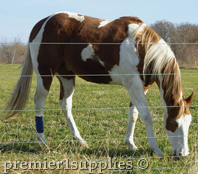
1. Don’t use high-tensile smooth wire fences around horses!
HT smooth wire can cause expensive and terrible injuries. The leg injury on this horse (our own!) came from a wire fence that was not protected by an offset hot rope.
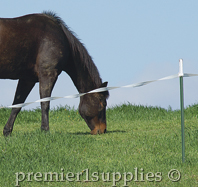
2. Don’t leave T post tops unprotected!
Steel T posts are strong and reliable. But their sharp steel tops can cause permanent, disfiguring injuries to horses. For safety, it’s always wise to put a plastic top on the posts. Our T post Hot Tops and T Post Safety Caps are effective solutions for sharp post tops.
What is important?
Visibility. Horses must see a fence to be able to avoid it. Our best conductors have contrasting black/white colors to ensure that they stand out visually against all backgrounds.
Conductivity. Ropes and tapes that are poor conductors (often found in farmstores) provide a strong shock near the energizer but only a weak shock at the far end. Good conductors (Premier's ropes and tapes) provide a uniform shock and allow the use of smaller energizers (and so less cost and risk).
HORSE FRIENDLY CONDUCTORS
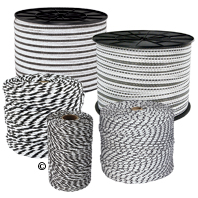
Electrifiable Rope, Twine & Tape
| • |
Visible. Safe. Reliable. |
| • |
Proven by extensive field tests. |
| • |
Backed by our expertise, world-class reputation and legendary service. |
Our prices for electrifiable rope, twine and tape are much lower than you will find anywhere else—so much that we can usually ship them to your door for less than you would pay at the local farmstore.
How can Premier afford such low prices?
| 1. |
We buy direct from manufacturers in container loads. |
| 2. |
We sell direct to you.
| • |
Premier conductors are made to our specifications. They’re the result of over 35 years of testing, observing, analyzing, modifying and retesting. We continue to “tweak” the specifications—because all products can be further improved. |
| • |
We are interested in what works and what might fail for specific purposes for specific species. We are not interested in what sells best, fancy packaging or exaggerated claims. |
|
Our goal is simply to supply you with a choice:
| • |
We offer unique and proven products with features and capabilities not found with other suppliers. |
| • |
We also offer products similar to those found elsewhere. |
| • |
This allows you to compare and buy at the level that suits your current fencing needs. |
Need more information?
PORTABLE KIT OPTION
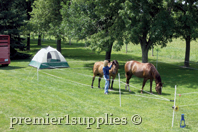
Premier's Trailer Paddock Kit
Try this ready-to-go, low-cost portable fence package. The kit includes everything needed to temporarily enclose horses on the trail, at the show or for other short-term applications.
|
 |
 |
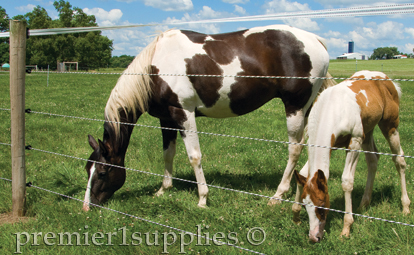
Introducing horses to electric fencing
Our preferred method of introducing horses to electric fences is the same whether or not the horse has previous exposure to this type of fencing. This does, of course, assume the fence has the correct level of visibility for the individual horse's personality.
Always make the introduction in daylight, at least several hours before dusk and preferably in the morning. Have the horse in its usual halter/lead rope, then walk together along the electrified fence line—not close enough for either the horse or yourself to be pushed into it—simply showing the horse where the fence line is. If this is a new barn or run-in, then take the horse into the center of the paddock to turn loose. A new paddock from an existing barn just requires opening the gate.
Over the course of time a horse new to electrified fencing will brush up against the fence—it rarely takes more than twice for them to recognize the "hot" fence and stay several inches away from it in the future.
If introducing multiple horses, walk each along the fence line individually before you turn any of them loose. By using this method you can be assured that the horse correlates the shock with the fence (and is something to be avoided) rather than the halter or yourself.
Fencing mistakes and solutions—
1. Electrical failure: No measurable pulse running through the fence.
Solution: determine if the problem is the energizer or the fence:
| • |
To check—turn off the energizer. |
| • |
Then disconnect the wires going to the fence and ground-rod system. |
| • |
Turn the energizer back on. |
| • |
Then measure the voltage between the 2 terminals (fence and earth) on the energizer with a digital fence voltmeter or other fence testing device (place a probe onto the “-” terminal and a probe onto the “+” terminal). |
| • |
If the tester reads less than 4000 volts, the energizer is the problem (or possibly the battery if it’s a battery energizer). |
| • |
If the tester reads more than 4000 volts, the fence is the problem and the energizer is working properly. |
2. Rotting/bad permanent fencing.
Solution: Scare wire/guard strands—Adding 1 or 2 energized strands to any wood, vinyl or wire fence helps to protect horses from a fence (and the fence from the horse).
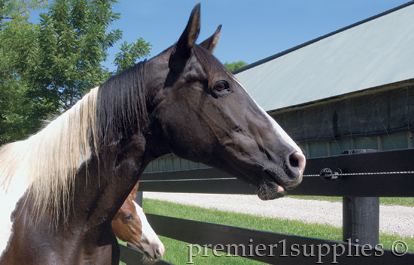
| • |
Place the “hot” strand at the height of your horse’s nose when it walks. |
| • |
Use insulators to support them. |
| • |
The distance a strand should be held away (offset) from a fence varies. For vinyl or wood fences, 2" is enough. For HT wire fences we think the maximum (about 7") is best, because the risk of injury is greater. |
3. Inadequate visibility/height of fence.
Solution: Premier's Permanent Combination Fence
The following design is very adequate to keep in horse and foals and keep out predators. We have equine fences with all tape, all rope, and combination rope/tape. We prefer the combination fence. Why?
| 1. |
Four strands of wide tape are a little too visible for those who prefer to see their horses instead of a fence. (For this fence set-up, place strands at 60", 45", 30" and 15".) |
| 2. |
Rope needs less maintenance than tape. It’s much less affected by wind, rain, ice and snow. (In 2008 our lower ropes were pulled down by the deep snow. After the snow melted, the rope looked as it did before the snow. Tape will need to be retensioned if this occurs.) |
| 3. |
Including a strand of wide tape makes a more visible barrier than an all-rope fence for stallions, foals, yearlings, hot-blooded breeds and mares during weaning time. |
| 4. |
For a 5-strand fence, place strands at 60", 48", 36", 24" and 17". For most 2-strand fences place strands at 48" and 24". |
VISIBILITY
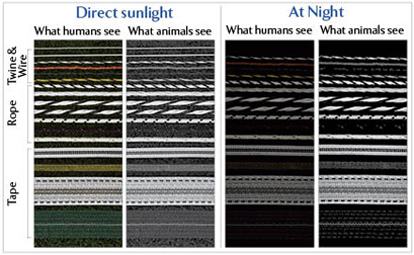 These photos show, in descending order, MaxiShock, HT wire, IntelliTwine, polywire, rope, braided rope, tape. They simulate both direct sunlight and “nightlight.” To simulate animal vision, we eliminated the color and enhanced the amount of “light at night.”
These photos show, in descending order, MaxiShock, HT wire, IntelliTwine, polywire, rope, braided rope, tape. They simulate both direct sunlight and “nightlight.” To simulate animal vision, we eliminated the color and enhanced the amount of “light at night.”
Vision Comparison
Key conclusions:
• Size in diameter or width matters—larger is always better for visibility.
• Contrast matters—black/white is much more visible than solid white, green, orange or black.
Which conductor is the most visible?
The relative visibility to both animals and humans is critical. Why?
| 1. |
If it’s easy to see, the more likely it will stop livestock and wildlife. |
| 2. |
Visibility = Avoidance = Safety. |
But there are major differences between animals and humans in the ability to see fences. Animals see color poorly. Their world is largely black, white and shades of gray. Most animals have better night vision than we do.
Translating this data into horse fences, we can make these conclusions:
| 1. |
Horses see wood and plastic board fences well because of the large size of the boards. And long, smooth, straight black or white strips (boards) aren’t common in nature. |
| 2. |
Tapes and rope that are white (only) are less visible because they don’t contrast against light backgrounds. |
| 3. |
HT wires are difficult for a horse to see because the wire is small and has very little contrast against most natural backgrounds. |
| 4. |
Tape is very visible because of its size, its motion (in the wind) and its ability to reflect light at night. |
| 5. |
IntelliTape is the most visible of the narrow tapes because its black-and-white color has the most contrast with both light and dark backgrounds. |
| 6. |
Tapes and ropes that are 100% green or brown are more difficult for horses to see because they do not contrast against green and brown vegetation. |
Every fence must be easily seen by horses and people...
Because their eyes are on the sides of their heads, horses are less able than cattle or people to see small objects directly in front of them when running. That’s why horses occasionally run into steel-wire fences—and in doing so, risk injury and/or escape. And escaped horses are serious road hazards.
Knowing this, we designed our ropes and tapes with the equine vision capabilities in mind. That’s why:
1. They have contrasting colors—to be visible against all backgrounds. (We were the first to offer black-and-white tapes and ropes. That we were right to do so has been proven by our many imitators.)
2. They’re flexible and large enough in width/diameter so that direct impact by a horse rarely results in injury.
See our Fencing for Horses recommendations.
Warning: Do not use high-tensile smooth wire fences for horses!
High-tensile wire fences look nice, are not expensive and are easy for contractors to install. Nonetheless, Premier advises against such fences for horses though we promote them for other species.
Why? Because HT wire can produce terrible equine injuries. The wire is very strong yet small so it behaves like a cheese cutter on flesh when accidently kicked or impacted at speed. It’s difficult for horses to see most HT wires, so they are less able to avoid them. If you already have such fences, it’s a potential injury in waiting. As a fix we suggest installing an offset strand of energized rope to enable horses to better see and avoid the wires.
|
|